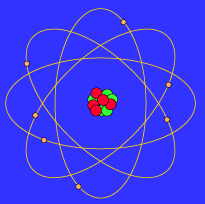As indicated in the previous section, all ionic compounds are comprised of a definite ratio of cations and anions. This ratio of ions within the ionic compound is determined by the oxidation state of the cation and anion. In every ionic compound, the total positive charge of the cations must always equal the total negative charge of the anions, so that the net charge of the complex is always zero. Every ionic compound can be described by an ionic formula unit which lists the simplest whole number ratio of the ions in the ionic crystal lattice formed. The simplest whole number ratio of the sodium and chloride ions the network of ions shown above is:

Hence, the chemical formula for the ionic compound sodium chloride, " NaCl ". See exercise 3
Ionic compound – transition metals
The behavior of the Transition metals is similar to that of the Representative metals. They are also oxidized by nonmetals, losing their electrons to the nonmetal and forming ionic compounds. However, many Transition metals exhibit multiple oxidation states, forming cations with different positive charges. This is due to the fact that many Transition Metals are characterized by a partially filled inner electron level, inside the valence shell. Electrons within this inner shell may sometimes behave as valence electrons and are lost along with the outermost electrons during oxidation. The number of electrons lost depends on the conditions under which the chemical reactions occur. Hence, many of these metals can exhibit "multiple oxidation" states, forming cations of different charges. A typical example is iron. Depending on the conditions of the reaction, iron may form a cation with a "+2" or "+3" charge, by losing two or three electrons, respectively. Manganese, another Transition metal and an extreme example, may exist in the following oxidation states: "+2, +3, +4, +6, and +7, by losing 2, 3, 4, 6, or 7 electrons, respectively. Because the number of electrons lost by the metal depends on so many variables (temperature, amount and nature of nonmetal, etc.) the exact chemical formula of ionic compounds formed by the Transition Metals must be determined experimentally. The simple whole number ratio of the atoms in the derived formula can then be used to determine the oxidation state of the Transition Metal



No comments:
Post a Comment